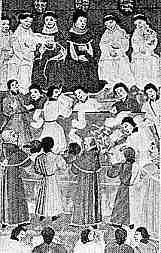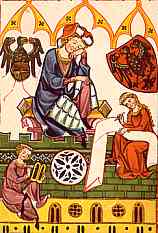




If you are looking at this page without frames, there is more information about medieval writing to be found by going to the home page (framed) or the site map (no frames).
| The Practice of Writing in the Middle Ages (3) | |||
| According to the eminent Hilary Jenkinson (Jenkinson 1927) the Scriveners' Company of London took on apprentices, but it is not known whether they taught them writing from the beginning, or whether they were expected to have a certain level of pre-existing skill. Scriveners were lay professionals who wrote for hire, mainly documents relating to such areas as conveyancing. They described themselves as "writers of the Court Hand", implying that a certain style of script was part of their professional accomplishment. | |||
| Chancery clerks and intending lawyers of the late middle ages shared some aspects of their literate education. The London Inns of Chancery, where minor clerks and candidates for clerkships learned their specialised aspects of the writing trade, also served as preparatory schools for the Inns of Court, where lawyers learned their skills. The legal profession included a significant proportion of lay people within its ranks. Extracurricular courses were also taught at Oxford for those who intended to enter the legal profession. These professions involved writing in the vernacular, so that the craft of writing encompassed different types of composition, in the form of legal documents and records, and different languages to those provided by a church education. The universities and even the grammar schools were essentially concerned with Latin literacy. Vernacular literacy was largely learned outside these institutions. |  |
||
| For a summary and some references on this subject, try John H.Fisher 1977 "Chancery and the Emergence of Standard Written English in the Fifteenth Century" Speculum 52, No. 4: 870-899. | |||
| Image from a rubbing of the memorial brass to John Martyn, Judge of the King's Bench in the church at Graveney, Knet, from 1436. | |||
 |
This education in legal literacy involved learning the terminology and structure of various classes of documents, as well as the standardised scripts used in their production. The "court hand", as they called it, was not a single unified script, as variants were used on official charters, less formal writs and for the tightly packed recording of the Chancery and Exchequer rolls, as well as for recording legal procedures from the courts of law. Towards the very end of the medieval era certain offices developed their own distinctive styles, starting with the Chancery and the Exchequer and proceeding through other offices in the Tudor era and beyond. | ||
| Scribes doing their stuff in the Chancery Court, from a late medieval illustration. | |||
| As for the minor local officials, manorial officials and business people who were required to learn writing skills to do their jobs, it must be assumed that there were various means of acquiring the necessary education outside formal institutions dedicated to the task. Parish priests and other local clergy may have played a part. Apprenticeship training presumably included learning such skills in literate jobs. Guilds may have contributed to the process. There may have been literate education in the family. While mothers were teaching their daughters elementary reading from their books of hours, fathers may have been teaching their sons the writing skills they needed to function in their professions and level of society. Every candidate in the Inns of Chancery may not have ended up as a clerk in the firm, some perhaps serving as ordinary scriveners and teachers of writing. | |||
| As far as lay writing for pleasure goes, the aristocratic classes were known to have included such accomplishments among the significata of their rank, whether it be lyric poetry or treatises on gentlemanly pursuits such as hunting, falconry or horse breeding. Once again, authorship does not necessarily imply the physical act of writing, but neither does the use of scribes taking dictation imply a lack of written literacy by the author. I am sure the great lords were capable of cutting up their own meat, but they didn't do it. The illustration at right, taken from a miniature in the Manesse Leiderhandschrift, a 14th century book of German aristocratic lyric poetry, shows one of the authors dictating to a female scribe wrestling in impractical manner with a long scroll and a male scribe with a waxed tablet. This author was reputedly blind, but there were those trained to take dictation should the necessity or desire arise. The inclusion of a female scribe is interesting. There are some suggestions that noble German ladies may have been more literate in writing than their English equivalents. There were some ferociously literate German abbesses. |  |
||
| This miniature depicts the poet Reinmar von Zweter. The original manuscript is in the Heidelberg University Library. All the miniatures depicting the poets can be seen on the website Die Miniaturen der Manesseschen Liederhandschrift. | |||
| Merchants, educated townspeople and the country gentry extended their pragmatic writing skills into areas for their own edification and enjoyment. In an era when any books purchased from a bookseller were an expensive luxury, those with writing skills compiled their own miscellanies, using cursive business hands and the relatively cheaper medium of paper. Compilations of this type are known as commonplace books, and may contain copies of literary works alongside devotional poetry, notes on the breeding of hunting dogs, and the prices of brocade in Venice. In relation to domestic written literacy among the Norfolk gentry, the compiler of the definitive edition of the Paston letters (Davis (ed.) 1971) has noted that the men of the Paston family appear to have actually drafted and written their own letters in their own hand some of the time, while at others they had apparently relied on the services of a secretary. The women, on the other hand, appeared to have relied entirely on the process of dictation to a secretary or scribe, even if the content was personal, inflammatory or potentially embarrassing. While there is some evidence for the encouragement of women's reading literacy in the 15th century, it seems that writing may have offered too much personal freedom to be allowed for most women. | |||
 |
|||
| This is the upper left hand corner of a letter of William Paston III, in his own hand, to his brother John Paston III, of around 1478 (British Library, add. ms. 27446, f.18). By permission of the British Library. | |||
| From around the early 15th century onwards, there have survived samples and advertisements by writing masters eager to display the range of scripts for very specific purposes that they could produce. The idea that there was a precise and correct form of script for each particular function had become part of the culture of writing. These writing masters also indicated that they gave instruction in these arts, although it is not apparent just how much pre-existing skill or level of literacy a pupil would have required. | |||
 |
An alphabet from a copybook by a German writing master, Johan Neudöfffers, of 1538. (From Steffens 1929) | ||
| The above example shows a small German Gothic book hand. | |||
| Given the social divisions and varying levels of access to education in the later middle ages, it is not possible to set universal benchmarks for writing literacy, such as fascinate our current generation of politicians. A significant proportion of the population probably never learned to write at all, even when they were involved in legal affairs that required written process. Appending a cross to a legal document rather than signing it, to indicate that a person had taken an oath to Christ as to its validity, is seen throughout the middle ages. On the other hand, many people were participating actively at some level in literate culture. The art of writing was practised for profit, for legal validation, for business recordkeeping, and for pleasure. | |||
|
|
|||
|
If you are looking at this page without frames, there is more information about medieval writing to be found by going to the home page (framed) or the site map (no frames). |
|||